What is wrong with my chickens feet?

A Guide to identifying and treating common foot problems in chickens.
Chickens are busy creatures that spend a lot of their time scratching around on the ground looking for food. Healthy feet are a very important to chickens and a bird with foot problems may be in pain and struggle to find food.
Chicken do not have as many feet problems as you might expect for an animal that uses them so much but there are a few problems that crop up over time that need to be treated and some that can be prevented.
Below: A free range chicken using its feet.
A birds foot is a specialised piece of equipment, it contains a network of tiny blood vessels that allow the foot to keep working even when its is very cold by acting as a heat exchanger.
Table of Contents
- A Guide to identifiying and treating common foot problems in chickens.
- How do you know if a chicken has foot problems?
- What should a healthy chickens foot look like?
- What is wrong with a chicken that is limping or cannot walk?
- Injuries, sprains and broken bones:
- Amputations or Missing toes:
- Genetic problems with feet:
- Curled feet and toes:
- Bumble-foot:
- Mud and dung balls on the toes, sometimes called Convicts foot:
- Mycoplasma Synoviae:
- Scaly Leg Mites:
- Toe Nails:
- Spurs:
- Gout:
- Frost Bite:
- Mareks and disease:
- Feathery feet:
- Treating foot problems:
How do you know if a chicken has foot problems?
You should catch you chicken and examine the foot to determine where the source of the problem is. If the foot is fine take a look at the what's wrong with my chickens legs section of the site.
A chicken with foot problems may:
- Be stood still.
- Balancing itself with its wings.
- Limping, hopping or favouring one leg over the other.
- Unable to perch.
- Swaying while stood still.
- Pecking at its foot or pulling at its own toes.
- Have hot, swollen joints or inflammation.
One off the reasons foot problems in chickens take time to notice and diagnose is the birds are very good at hiding small problems until the become big ones. Chickens in pain tend to stand still and itching or irritation tend to cause pecking and scratching.
What should a healthy chickens foot look like?
A healthy foot (In most breeds) should have four complete toes ending in a claw. Three point forwards and one backwards.
The toes should be evenly spaced, flexible and the pads underneath free of infection, lumps and cuts.
The scales covering the foot should be even and smooth although in older chickens there may be a few missing which is to be expected.
Below: A healthy foot on a chicken.
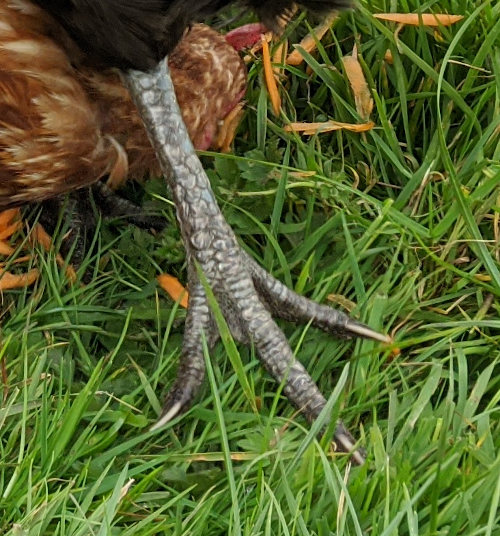
You can test a chicken grip with its foot by putting your index finger up against the pad to see if the bird grips your finger.
What is wrong with a chicken that is limping or cannot walk?
It might seem like a there is a long list of foot problems but most are rare and quite a few of them are easy to prevent.
- Injuries like sprains, strains and broken bones.
- Amputations.
- Genetic problems.
- Curled feet or toes.
- Bumble-foot.
- Mud or dung ball toe, sometimes called convicts foot.
- Mycoplasma Synoviae.
- Scaly Leg Mites.
- Toe Nails.
- Rooster Spurs.
- Gout.
- Frost Bite.
- Mareks and other diseases.
- Feathery feet can be a problem.
Injuries, sprains and broken bones:
Serious injuries in chickens feet are not that common as chickens feet are covered with a tough skin and scales.
A few things to watch out for a sharp edges in the the coop or on the nesting boxes. Metal will cut easily and allow infections in. Chickens feet can be injured by sharp edges, broken glass or sharp points on screws or nails.
Below: A chick with a cut leg. Clean, cover and isolate the bird in the dry until healed.
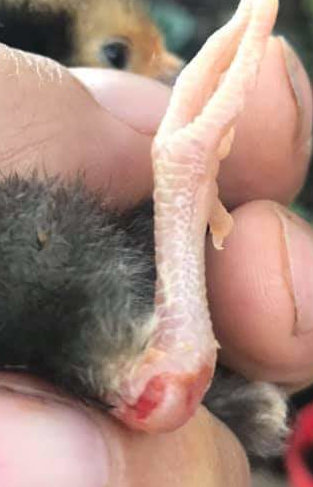
Injuries to the foot should be treated by cleaning and covering the foot with clean dressing and keeping the chicken in the dry until the wound heals. Small cuts can be treated at home but deep wounds will likely require antibiotics so you may need to visit a veterinarian.
I have had chickens with broken toes over the years and have never noticed at the time. In every case It healed at a funny angle and I spotted it at a later date.
Below: Chicken with broken toes that have healed at funny angles. You will need to clip the claws regularly.
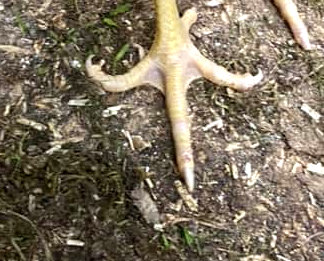
Chickens are more or less immune to the effects of a broken toe and they heal quickly.
Get the opinion of a vet if you are unsure about treatment.
Amputations or Missing toes:
Chickens lose toes for all sorts of reasons, I had one that had a horse stand on her toes and she lost the ends of two on one foot. There was a lot of screaming and flapping until the horse moved and I wasn't able to catch her until she roosted. The bleeding had already stopped and she recovered completely.
Below: A cockerel with a missing toe.
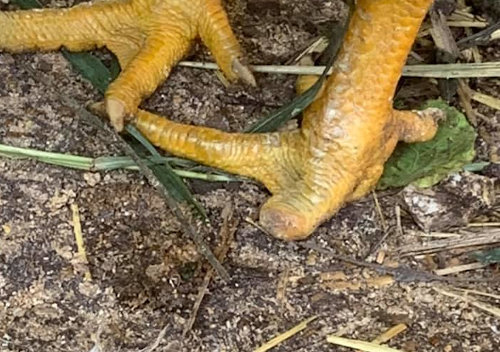
A chicken can survive losing a toe or two with little effect on its life.
A missing toe will bleed quite a lot and will need dressing to prevent infection for a week or two until it heals.
Treatment is cleaning the foot and covering the wound. Get veterinary treatment if the bleeding doesn't stop or you are worried about infection.
Genetic problems with feet:
There are a few breeds with genetic feet problems. The most obvious example is the Silkie which has an vestigial, or extra toe. Sometimes they can have two or even three surplus digits on their foot and this can lead to mobility issues.
There is no cure or treatment for genetic foot problems in chickens other than to never breed from affected birds.
You will need to asses your chickens quality of life to decide on a course of action.
Curled feet and toes:
Curled feet and toes can be just a single toe that is a little curled or the entire foot may be rolled on one side. From my experience chickens manage fine with curled toes and as long as they are not in any pain they can be left to get on with their life.
Simple cases can be taped to a thin plastic "duck foot" cut out for a week or two but bad cases won't respond to intervention.
More often a problem with heritage breed chicks raised artificially in incubators or on brooders with the wrong type of floor covering.
Below: Curled toes. It is difficult to tell if it is caused by improper incubation or genetic issues.

Curled toes is also an indication that the temperature control in your incubator is wrong. Both high and low average incubator temperature can cause all sorts of skeletal issues in young birds.
Bumblefoot:
Bumblefoot or pododermatitis in chickens is an infection of the pad of the foot. It presents as a hard pus filled abscess with a characteristic scab on the bottom of the foot.
Below: The classic presentation of bumblefoot in chickens, an abscess in the foot covered with a dark scab.
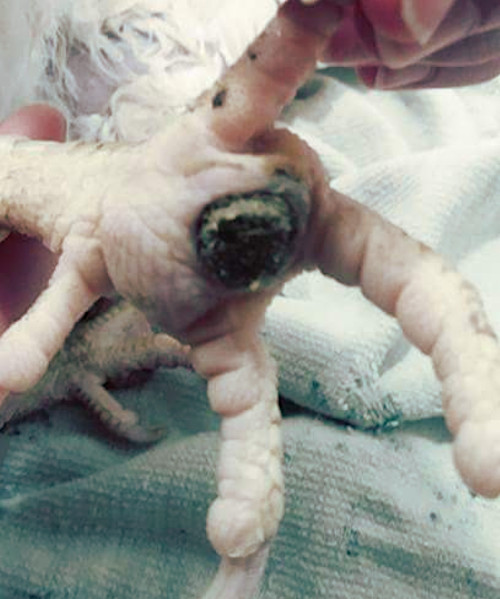
Mild cases can be treated by bathing in Epsom salts and covering the foot with a bandage but bad cases require surgery to excise the abscess. This site has a whole page dedicated to treating and caring for chickens with bumblefoot.
Mud and dung balls on the toes, sometimes called Convicts foot:
Chickens get dung and mud balls on thier toes when they move between wet, muddy environments and dry parts of the run where there is sawdust. Chickens then get solid lumps of mud and fibres accumulating on the end of their toes.
Each time they go from wet to dry the toes accumulate another layer. It can also happen on in damp coops and runs or on a heavy clay soil.
Below: A chicken with dung and mud balls on its toes.
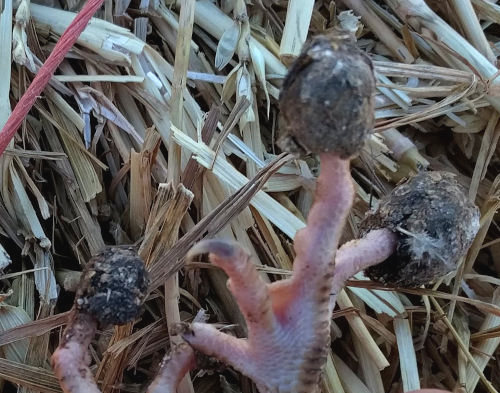
It is called convicts foot because the ball set solid and the bird has to drag it around like a convicts does with a ball and chain.
Treating these lumps takes a little time. You cant just pull them off as it may damage the toe or the nail. To treat poop balls on the toes of chickens you need to soak them in hot water for a few minutes and then add a drop or two of olive oil for lubrication.
Mycoplasma Synoviae:
If your chicken has a swollen foot that is not bumble-foot then it is likely to be Mycoplasma Synoviae.
Mycoplasma Synoviae is a highly infectious bacterial disease that can be caught from other chickens, wild birds or passed through the egg to the young. It manifests in several ways including internal infections but the most noticeable comes when it infects the tendons and synovial fluid in the legs causing pain, severe swelling, hot joints, lameness and large fluid filled blisters in the feet.
Below: A foot infected with Mycoplasma Synoviae. Large painful swellings are present over large areas of the foot.
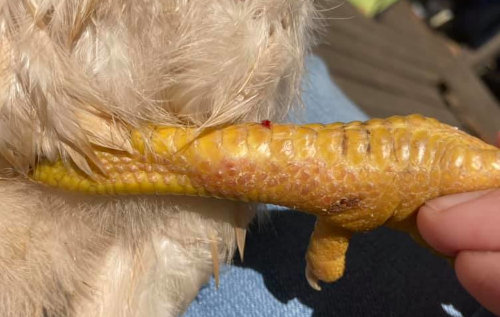
Treatment for Mycoplasma infection is a course of antibiotics.
Scaly Leg Mites:
The scaly leg mite is a small external parasite that lives under the scales on a chickens legs and feet. Scaly leg mites can't be see with the naked eye and you only know your chickens are infected when the scales dry out and begin to flake. These small grey mites travel from foot to foot along the roost and can drive chickens mad with irritation.
Scaly leg mites are small and are not able to be seen by the naked eye. Cases are slow to progress and will gradually infect both legs of every bird in the flock given time.
Below: A chickens foot with Scaly leg mite.

Treating Scaly leg requires a chemical treatment like ivermectin and Vaseline rubbed deeply into the legs to smother the mites and soften the skin and scales to aid healing. The mites have a life cycle between 1 and 3 weeks and treatment needs to be repeated until the condition has cleared completely.
Toe Nails:
Chickens allowed to scratch in the dirt seldom ever have problems with their claws because they wear them down as they scratch in the ground. Those flock members kept confined or with malformed feet may end up with overgrown claws that need to be trimmed.
Below: Overgrown claws on chickens need trimming on a regular basis.
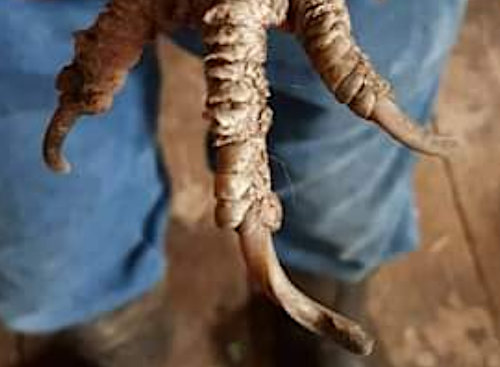
Trimming claws is easy, just clip the end with nail clippers and file gently with a nail file to shape and remove any sharp edges.
Chickens with badly overgrown claws may need treating in several stages as trimming the nails too short will expose the quick in the middle of the nail which is painful, causes bleeding and may allow infection in.
Spurs:
Spurs can become a problem on older birds and the problem is not exclusive to cockerels, hens grow spurs as well albeit at a slower rate. As spurs grow the they twist upwards and the points can end up being a problem.
Treating spur problems is easy. They can be blunted with a file, clipped with nail clippers or removed entirely.
On older cockerels the spurs can grow to several inches long and begin to curl upwards. Clipping a few millimetres off the tip of the spur and use a file to round off the end should be all you need to do.
A second treatment may be required a few weeks later. Spurs can be removed with a pair of pliers, a firm grip and some wiggling but it is traumatic and should be avoided if you can. I have had several roosters over the years that have lost a spur and it never affected them at all.
Gout:
Gout in chickens is a painful form of arthritis that happens when uric acid crystals form in the joints. It is not a disease in itself but a symptom of kidneys problems. Gout makes scratching, walking and perching uncomfortable at best and quite painful at worst.
An affected chicken may seem to be stiff in the morning and choose to stand still rather than be actively scratching about.
Gout has no cure but can be treated and you will need to see a veterinarian.
Frost Bite:
Chickens can normally cope well with icy, frosty or snowy conditions as their feet and legs are well suited to working in the cold.
They have a complex biology that allows them to work well in the cold. It can happen that the tips of the toes freeze, turn black and fall off and the chicken will be left with stumps.
Below: A chicken with frost bitten toes. Infection will require a vet to treat, otherwise isolate in the warm and dry until the foot heals.

I rescued a few birds that had been dumped on waste ground and two of them had frost bitten toes, both went on to have normal lives and it never troubled them.
Mareks and disease:
Mareks can cause lesions on the nerves resulting in a variety of mobility symptoms from limping to paralysis. Birds either recover or they die.
I have a whole page on Mareks disease in chickens.
Feathery feet:
Feathery feet is not a problem on its own but it can lead to other issues and the feathers can cover over other conditions like Scaly leg mites.
Chickens with feathery legs and feet can suffer more foot problems than other breeds. Wet and muddy foot feathers can hold water and cause chilling and they can hold mites as well.
Pekins are like sponges in wet weather and should only be kept in the dry.
Treating foot problems:
Treating foot problems in chickens sometimes needs two people.
Here is a list of supplies you will need for treating foot problems in chickens:
- A large towel for wrapping the chickens in to hold them still.
- Disposable gloves to stop transfer of infectious materials.
- Soap, scrubbing brush and alcohol wipes.
- Nail clippers.
- Instruments like tweezers, small scalpel and a pair scissors.
- Hydrogen Peroxide.
- Elasticated bandage and gauze. Self adhesive is the best.
- A selection of different sized syringes for wound irrigation.
- Saline. Eye wash works well.
- Vaseline.
- Neosporin.
Picking chickens off their perch at night is a good time to work on the feet as they are more calm in the dark.
The first job should always be to clean the feet. Use hand hot water and some soap and the scrubbing brush if necessary and then dry thoroughly.
